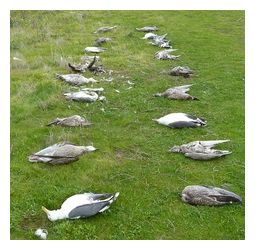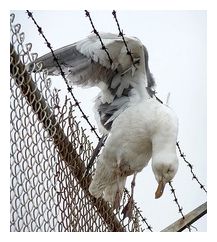
© Richard DrechslerDead sea gulls collected over 2 weeks at Pier 94.
Western gulls have been dying at an alarming rate over the past decade at San Francisco's industrial Pier 94, and preliminary results of a state investigation that found deadly mold inside the bird's lungs are only deepening the mystery surrounding the carnage.
Bird rescuers who recover sick and dying gulls every other day or so from a small industrial patch of waterfront land have long blamed a
Darling International-run rendering operation for the deaths.
But, in new findings that are disputed by the bird rescuers, a preliminary California Department of Fish and Game investigation cleared the facility of responsibility for most of the deaths.
The department found 15 to 20 dead or dying gulls monthly, according to California Fish and Game Warden William O'Brien. It performed autopsies on a number of dead gulls and found that growing inside their lungs was a mold called aspergillus, which suffocated the birds.

© Richard DrechslerA dead sea gull at Pier 94.
The source of the mold, which occurs naturally at lower concentrations, remains under investigation.
O'Brien told the San Francisco Commission of Animal Control and Welfare Thursday that the mold is suspected of coming from one of the many industrial operations in the vicinity of Pier 94. The wide territory covered by western gulls, which nest at Alcatraz and other shoreline areas and famously flock to AT&T Park during the bottom of ninth innings, makes it difficult to locate the source of the mold.
A recycling sorting operation operated nearby by Recology and dirt-hauling business Waste Solutions Group were named in a
San Francisco Examiner report as potential sources of the mold. O'Brien said Thursday that other operations in the area are also being investigated.
The birds are likely dying because they are eating or inhaling the mold in unnatural quantities, according to O'Brien.
"It seems like for all the birds coming back with
aspergillus, it's all in their respiratory tracts," said O'Brien.
Officials at Recology and Waste Solutions Group said they were surprised by the findings and said they doubted that their operations were to blame.
"Everything we do is containerized, so it's either in bags or containers; nothing hits the atmosphere and nothing hits the ground," said David Gavrich, president of Waste Solutions Group, which hauls contaminated dirt.
"We're handling dry materials - just bottles, cans and paper," Recology spokesman Robert Reed said. "There's no odor, there's no food and we move the materials through every day very quickly so we don't have any mold."
Bird rescuers and local environmentalists on Thursday said it was too simplistic to rule out the possibility that the Darling International rendering facility may have played a role in the deaths.
About 10 percent of the birds studied by the department were sickened by oil on their feathers, which can cause hypothermia and could have come from the rendering plant, according to O'Brien.
The gulls feast on discarded kitchen oil and rotting meat in trucks that deliver waste to the facility, where it is turned into ingredients for cosmetics and animal feed. The bird rescuers say the gulls die from hypothermia after their feathers are covered with grease or from diseases after eating rotten food.
O'Brien, however, praised the company's efforts to enclose its operations as thoroughly as possible to keep the gulls out of the rotting waste.
"When a living organism like mold is killing wild animals, there are almost always one or more underlying problems in the ecosystem which are making the animals susceptible to the mold or other organism," environmentalist Eric Brooks said in an e-mail.
"The basic reality here is that it is unacceptable that any gulls at all are able to get into Darling's waste fats and become contaminated by them, and the Port and Board of Supervisors should step in immediately to demand that Darling clean up its act," Brooks said.
Bird rescuer Kelle Kacmarcik said she has seen a spike in the number of gulls near the Darling facility with oil-covered feathers.
"Since Feb. 23, I've caught three oiled birds, found one freshly dead and am tracking one medium to lightly oiled bird," Kacmarcik said in an e-mail.
Darling International has not returned phone messages regarding gull deaths in its neighborhood left by The Bay Citizen since November.
Perhaps they are ones who ate some of those Redondo Beach anchovies.